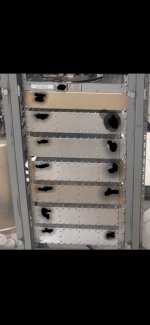Wow. That's a pretty-well-funded ham club.

VERY. They own two tower sites with one of them having a major cellular carrier an anchor/preferred tenant, weather radio, and 2 LMR tenants, the other owned site has a WISP, and weather radio. Most of the multicouplers in the photo were donated by companies/PS agency upgrades. They also have a healthy amount of VHF gear. Not shown is 4 racked VHF, 4 cavity multicouplers.
The main site tower, containing the equipment in the photo, was built by the cellular tenant, and after a 25 year long contract for the use of the club land, turned ownership over for $1, at which time the carrier started paying to be there.
There is still lots of work to upgrade all the interconnecti cables to eliminate some LMR400 we have found at the site. Our aim is to be using superflex between all cavities and repeaters, and between cavities and feedlines.
Grounding also needs to be upgraded, as it's really unknown what actually is a system ground, and we need to tie, properly, into the tower ground system.
All in all, there was a lot of neglect over the last bunch of years, with a lot of poor quality work done by well meaning people, that have no business touching it.
We already have taken dozens of feet of LMR400, and more adaptors than I care to count out of the various RF chains at the site.
There is still a single VHF MSR2000(to be replaced by a MTR200, that was had a preamp, feeding a second preamp.
It's been eye opening experience working through cleaning up this site. We went from 9 multicouplers(4x VHF and 5x UHF) sitting on the floor, to being racked properly. We have added P25 and started moving gear around to minimize feedline length.


